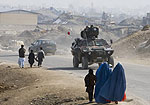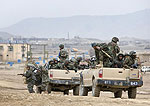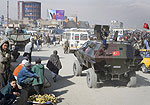Opinion leaders visit NATO’s Afghanistan mission
From 24 February to 2 March 2007, a selected group of senior editorialists and representatives of the think-tank community from Hungary, Italy, Lithuania, Spain, and Slovakia participated in a NATO-sponsored tour of Afghanistan.
The programme included meetings and discussions at NATO HQ in Brussels as well as a wide range of activities on the ground in Afghanistan, including meetings with Afghan, NATO, UN and EU representatives, and visits to key projects, including at the provincial level.
While in Afghanistan, the group observed the training of the Afghan National Army (ANA) at the Kabul Military Training Centre. They met with international instructors and Afghan military officers and observed a military exercise conducted by ANA units. This provided an opportunity to assess the current prospects for the expansion of the Afghan National Army.
First-hand look
The participants also travelled to Wardak (Regional Command East) and Herat (Regional Command West) to observe the activities of two of the 25 NATO/ISAF-led Provincial Reconstruction Teams (PRTs).
In Wardak they met with civilian representatives of the PRT, led by Turkey, and with the provincial governor and other representatives of the local administration. The visit to the Wardak PRT provided a useful framework to witness a significant range of civilian-led reconstruction and development projects, as well as to address with Afghan interlocutors some of the most prominent trends in the consolidation of Afghan governance.
The visit to the Herat PRT, led by Italy, consisted of meetings with the Italian Commander of Regional Command West (Brig Gen. Satta) and with representatives of other troop contributing-nations, briefings and discussions on the various activities carried out by this PRT, and visits to reconstruction projects in Herat and its surroundings.
Overall, this initiative provided several highlights of the progress achieved, of the ongoing efforts to consolidate stability, and finally of the importance to address through a truly comprehensive approach between Afghans and all the actors of the international community the various aspects of the Afghan stabilization process.


